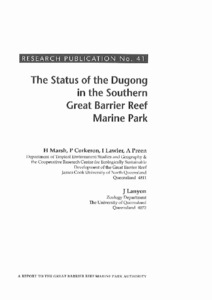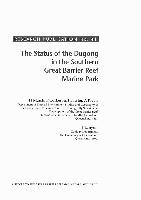Please use this identifier to cite or link to this item:
https://hdl.handle.net/11017/255

Full metadata record
| DC Field | Value | Language |
|---|---|---|
| dc.contributor.author | Marsh, H. | * |
| dc.contributor.author | Corkerton, P. | * |
| dc.contributor.author | Lawler, I.R. | * |
| dc.contributor.author | Preen, A. | * |
| dc.contributor.author | Lanyon, J. | * |
| dc.coverage.spatial | Southern Great Barrier Reef | en |
| dc.date.accessioned | 2012-05-25T01:44:52Z | en |
| dc.date.available | 2012-05-25T01:44:52Z | en |
| dc.date.copyright | 1996 | en |
| dc.date.issued | 1996 | en-US |
| dc.identifier.isbn | 9780642230157 | en |
| dc.identifier.uri | https://hdl.handle.net/11017/255 | en |
| dc.description.abstract | Australia has international responsibilities for the management of dugongs in the Great Barrier Reef Region. One of the World Heritage values of the Region is that it "provides major feeding grounds for large populations of the endangered species Dugong dugon" (Great Barrier Reef Marine Park Authority (GBRMPA) 1981, p. 7). In addition, the dugong has high biodiversity value as the only species in the Family Dugongidiae and one of only four species in the Order Sirenia. AlI four extant species of Sirenian are listed as vulnerable to extinction by the IUCN (IUCN 1990). In 1986 and 1987, Marsh and Saalfeld (1990 a) counted dugongs, dolphins and sea t1\l11es during an aerial survey over an area of some 39,000 km' in the inshore waters of the Great Barrier Reef Marine Park south of Cape Bedford. Survey-and-taxon specific correction factors were used to correct for perception bias (the proportion of animals visible in the transect which are missed by observers) and to standardise for availability bias (the prop0l1ion of animals that are invisible due to water turbidity). | en |
| dc.language.iso | en | en |
| dc.publisher | Great Barrier Reef Marine Park Authority | en |
| dc.relation.ispartofseries | Research publication series no. 41 | en |
| dc.relation.ispartofseries | Research publication | - |
| dc.subject | Dugong - Queensland - Great Barrier Reef | en |
| dc.title | The status of the dugong in the southern Great Barrier Reef Marine Park | en |
| dc.type | Report | en |
| dc.subject.asfa | Marine parks | en |
| dc.subject.asfa | Protected areas | en |
| dc.subject.asfa | Aerial surveys | en |
| dc.subject.asfa | Hunting | en |
| dc.subject.asfa | Gillnets | en |
| dc.format.pages | 83 | en |
| dc.subject.apais | Environmental management | en |
| dc.subject.apais | Indigenous peoples | en |
| dc.publisher.place | Townsville, Qld | en |
| dc.relation.connectiontogbrmpa | GBRMPA published this item | en |
| dc.subject.category | Animals | en |
| dc.subject.category | Ecosystems | en |
| dc.subject.category | Traditional use | en |
| dc.subject.theme | Managing Multiple Use | en |
| dc.subject.theme | Reef Ecosystems and Species | en |
| dc.keywords | dugong | en |
| Appears in Collections: | Management | |
Files in This Item:
| File | Description | Size | Format | |
|---|---|---|---|---|
| The-status-of-the-dugong-in-the-southern-Great-Barrier-Reef-Marine-Park.pdf | 14.07 MB | Adobe PDF |  View/Open |
Items in ELibrary are protected by copyright, with all rights reserved, unless otherwise indicated.
